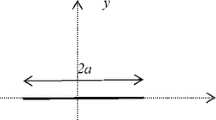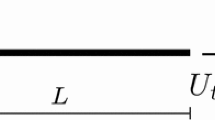Abstract
In recent years the problem of fracture initiation at stress concentrations has been studied using the theory of continuous distributions of dislocations, thereby allowing the elastic-plastic characteristics of the material to be taken into account. Particular attention has been given to the behavior of an isolated defect in an infinite body, the condition for fracture initiation being the achievement of a critical displacement at the defect tip, and for low stress fractures it has been demonstrated that the fracture criterion reduces to that derived from energetic considerations by Griffith, Orowan and Irwin; it was also shown that the length of plastic zone at fracture is independent of the length of the defect and the applied stress. The general analysis of the present paper indicates that these two conclusions are also valid for bodies that contain distributions of defects, even though these may be very close to each other and thus also for the case of defects in bodies of finite size; two particular problems are discussed as illustrative examples of the general situation.
Résumé
Dernièrement le problème des ruptures qui ont leur origine dans des concentrations locales de contraintes s' est fait le sujet de travaux qui se basent sur la théorie de la distribution continue de dislocations, ce qui permet de tenir compte des caractéristiques élastiques et plastiques de la matière. Une attention particulière a été consacrée à la tenue d' un défaut isolédans un corps infini, la précondition pour le commencement de rupture étant la réalisation d' un déplacement critique á l'éxtrémité du défaut, et on a montré que, pour les ruptures dans des conditions de contrainte réduite, le critère de rupture se réduit à celui dérivé des considérations énergétiques par Griffith, Orowan et Irwin. On a aussi montré que la longueur de la zone plastique á l'instant de rupture est indépendante de la longueur du défaut et de la contrainte appliquée. L'analyse générale que nous avons developpée indique que ces deux conclusions sont également valables pour le cas des corps contenant des défauts distribués, bien que ceux-ci puissent être très proches l'ún de l'a utre, et alors aussi pour le cas des défauts dans un corps fini. Deux problèmes particuliers sont discutés à titre d' example afin d' expliquer la situation générale.
Zusammenfassung
In den letzten Jahren untersuchte man das Problem der Brucheinleitung an Spannungsanhäufungen unter Heranziehung der Theorie der kontinuierlich verteilten Versetzungen, wodurch die elastisch-plastischen Eigenschaften des Werkstoffes berücksichtigt werden können. Insbesondere befasste man sick mit dem Verhalten eines vereinzelten Fehlers in einem unendlichen Körper, wobei das Zustandekommen einer kritischen Verschiebung an der Fehlerspitze für die Brucheinleitung massgebend ist. Für Bruchvorgänge bei niedrigen Spannungszuständen hat es sich herausgestellt, dass das Bruchkriterium auf dasjenige bringen lässt, welches von Griffith, Orowan und Irwin aus energetischen Betrachtungen abgeleitet wurde. Ferner wurde gezeigt, dass die Ausdehnung der plastischen Zone beim Bruch von der Fehlerlänge und der einwirkenden Spannung unabhängig ist. Aus der allgemeinen Auswertung der vorliegenden Arbeit geht es hervor, dass diese beiden Schlussfolgerungen auch für Körper mit verteilt angeordneten Fehlern gültig sind, auch dann wenn letztere sehr nabe beieinander liegen, und damit auch für den Fall der Fehler in Korpern endlicher Grösse. Als Beispiele zur Erläuterung der allgemeinen Lage werden zwei spezifische Probleme besprochen.
Similar content being viewed by others
References
E. Smith International Conference on Fracture, Sendai (1965).
B.A. Bilby, A. H. Cottrell K. H. Swinden Proc. Roy. Soc. A., 272, 304 (1963).
A. A. Wells Proc. Roy. Soc. A.,285, 34 (1965).
4. A. A. Griffith Phil. Trans. Roy. Soc. A., 221, 163 (1921).
E. Orowan Rep.Progr.Phys., 12, 214 (1948–9).
G. R. Irwin Trans. Amer. Soc. Metals, 40, 147 (1948).
A. H. Cottrell Proc. Roy. Soc.A.,285,1 (1965).
E. Smith Proc. Roy. Soc. A., 285, 46 (1965).
G. R. IrwinJnl. Appl. Mech., 24, 361 (1957).
E. Smith Intnl. Jnl. Fract. Mech., 1, 204 (1965).
B. A. Bilby, A.H. Cottrell, E. Smith and K. H. Swinden Proc. Roy. Soc. A., 279, 1 (1964).
12.G.R. Irwin, J.A. Kies andH. L. SmithTrans. Amer. Soc. Test Mater. 58, 640 (1958).
E. Smith Proc. Roy. Soc. A., 282, 422 (1964).
N. Louat Phil. Mag., 8, 1219 (1965).
A. H. Cottrell Iron and Steel Inst. Spec. Rep. No. 69, 281 (1961).
Author information
Authors and Affiliations
Rights and permissions
About this article
Cite this article
Smith, E. Low stress fracture initiation at a stress concentration: Application of dislocation type models. Int J Fract 2, 552–560 (1966). https://doi.org/10.1007/BF00193693
Received:
Issue Date:
DOI: https://doi.org/10.1007/BF00193693




